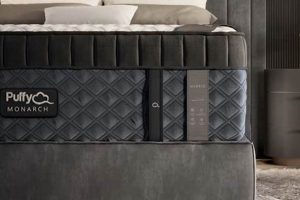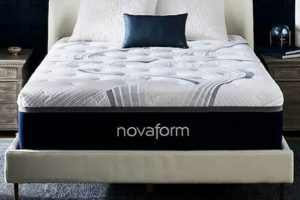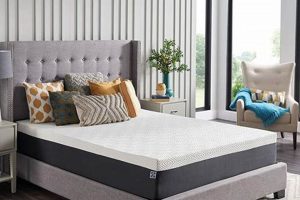Analysis of slumber product evaluations, specifically those pertaining to mattresses, serves as a crucial resource for consumers. These assessments typically encompass a range of criteria, including comfort levels, support capabilities, material quality, and long-term durability. For example, a compilation of consumer feedback regarding a particular foam mattress may highlight its pressure-relieving qualities while also noting potential issues with heat retention.
The significance of these evaluations stems from their ability to empower purchasers with objective insights into product performance. By studying a wide array of opinions and test results, potential buyers can mitigate the risk of investing in a mattress that fails to meet their specific needs. Historically, such information was limited to personal recommendations or manufacturer-provided details; however, the proliferation of online platforms has democratized access to extensive product reviews, leading to more informed purchasing decisions.
The following sections will delve into key areas related to mattress assessments, including the various testing methodologies employed, the identification of common complaint patterns, and strategies for interpreting consumer feedback in order to select an optimal sleep surface.
Insights from Mattress Performance Assessments
This section provides actionable guidance derived from the analysis of numerous mattress performance evaluations. These insights are intended to assist consumers in making well-informed purchasing decisions.
Tip 1: Consider Sleeper Type. Mattress suitability is heavily dependent on individual sleeping position. Side sleepers generally require softer surfaces to accommodate shoulder and hip pressure points, while back and stomach sleepers typically benefit from firmer mattresses providing adequate spinal support.
Tip 2: Evaluate Material Composition. Different materials offer varying levels of comfort, support, and durability. Memory foam excels at pressure relief but can trap heat. Innerspring mattresses provide good support and airflow but may transmit motion easily. Latex offers a balance of comfort, support, and breathability.
Tip 3: Examine Edge Support. Adequate edge support prevents roll-off and maximizes usable sleep surface. Mattresses with reinforced edges are particularly beneficial for individuals who share a bed or prefer to sleep near the edge.
Tip 4: Scrutinize Warranty Terms. A comprehensive warranty reflects the manufacturer’s confidence in the product’s durability. Carefully review the warranty for coverage periods, exclusions, and procedures for filing a claim.
Tip 5: Investigate Trial Periods. Many mattress companies offer trial periods allowing consumers to test the mattress at home. This provides a valuable opportunity to assess comfort and support before committing to a purchase. Return policies should be thoroughly understood.
Tip 6: Factor in Body Weight. Body weight influences the optimal mattress firmness. Heavier individuals generally require firmer mattresses to prevent excessive sinking, while lighter individuals may find softer mattresses more comfortable.
Tip 7: Assess Motion Isolation. For couples, motion isolation is a crucial factor. Mattresses with good motion isolation minimize the transfer of movement across the bed, reducing sleep disturbances.
Prioritizing these considerations, gleaned from widespread product assessments, significantly enhances the likelihood of selecting a mattress that aligns with individual needs and preferences, ultimately contributing to improved sleep quality.
The following sections will explore common methodologies used in mattress performance testing, providing further context for interpreting the findings presented in evaluations.
1. Objective Assessments
Objective assessments form a bedrock component of comprehensive mattress evaluations. These assessments, often conducted by independent testing laboratories, employ standardized methodologies to quantify specific performance characteristics. The relationship between objective evaluations and overall product analysis is causal; the data derived from these tests directly informs the conclusions drawn regarding the quality and suitability of a mattress. For instance, a pressure mapping test quantifies how a mattress distributes weight, providing insights into its ability to alleviate pressure points. This objective data then influences the comfort and support ratings found in a typical product analysis.
The importance of objective evaluations lies in their capacity to mitigate the inherent subjectivity of consumer feedback. While user reviews offer valuable experiential perspectives, they are influenced by individual preferences and circumstances. Objective testing provides a standardized baseline, allowing for a more direct comparison of different products. As an example, tests measuring motion transfer quantify the degree to which movement on one side of the mattress is felt on the other. These results are critical for couples and can be compared across different brands, irrespective of individual reviewer bias.
In summary, objective mattress assessments serve as a crucial counterweight to subjective experiences, enhancing the reliability and validity of sleep surface evaluations. The rigorous data acquired through standardized testing methods informs the practical application of selecting a product that aligns with individual needs and preferences. The integration of both objective and subjective information creates a more comprehensive and trustworthy resource for mattress consumers.
2. Consumer Experiences
The incorporation of consumer experiences is a vital component of product evaluations, particularly within the context of “sleepy mattress reviews.” These subjective accounts, detailing individual interactions with a specific sleep surface, directly influence potential purchasers’ perceptions of product efficacy and overall satisfaction. The cause-and-effect relationship is demonstrable: positive user narratives frequently correlate with increased sales and brand loyalty, whereas negative experiences often dissuade prospective buyers. The absence of documented consumer feedback would render mattress evaluations largely incomplete, relying solely on objective metrics which may not fully capture the nuances of real-world usage. For instance, a mattress may perform exceptionally well in laboratory tests, demonstrating optimal pressure distribution. However, if a significant number of consumers report persistent back pain or discomfort, this subjective feedback becomes a critical counterpoint, raising concerns about the mattress’s suitability for a broad range of users. The practical significance of this understanding lies in recognizing the power of shared experiences in shaping market trends and informing pur
chasing decisions.
Considerable variation exists within reported consumer experiences, reflecting differing body types, sleep preferences, and pre-existing health conditions. One consumer might praise a memory foam mattress for its contouring abilities and pressure relief, while another might criticize it for retaining excessive heat and lacking adequate support. Therefore, the effective utilization of these insights requires careful consideration of sample size, demographic representation, and the identification of recurring themes. For example, if a specific percentage of reviewers consistently mention difficulties with edge support, regardless of their individual preferences, this indicates a potential design flaw requiring further investigation. Moreover, the verification of review authenticity becomes paramount to mitigate the risk of biased or misleading information. Platforms employing robust verification mechanisms enhance the reliability of consumer feedback, increasing its value as a resource for prospective buyers.
In summary, consumer experiences constitute an indispensable element of comprehensive “sleepy mattress reviews.” By integrating subjective user feedback with objective performance data, a more holistic understanding of a mattress’s strengths and weaknesses emerges. The challenges associated with interpreting diverse and potentially biased reviews can be addressed through careful analysis of sample size, demographic representation, and the verification of authenticity. The practical significance of incorporating consumer experiences ultimately resides in facilitating more informed purchasing decisions, promoting consumer satisfaction, and driving product innovation within the mattress industry.
3. Material Analysis
Material analysis is an indispensable element of rigorous mattress evaluations. The composition of a sleep surface directly influences its performance characteristics, durability, and overall suitability for various sleepers. A causal relationship exists between the materials utilized and the resulting comfort, support, and longevity. For example, a mattress core constructed from high-density polyurethane foam will likely exhibit greater resistance to sagging and compression over time compared to a low-density alternative. Therefore, any thorough mattress review must incorporate a detailed assessment of the materials employed in its construction. The practical significance of material analysis lies in its ability to provide consumers with objective insights into the long-term value and potential shortcomings of a product. Without this crucial component, evaluations would be limited to subjective impressions and short-term performance observations, failing to address the critical aspect of durability.
The examination of mattress materials typically involves identifying the specific types of foam, coils, or latex used, as well as assessing their density, quality, and certification status. For instance, memory foam density, measured in pounds per cubic foot, correlates directly with its resilience and pressure-relieving properties. Similarly, the gauge and coil count of an innerspring system impact its level of support and motion isolation. Certifications such as CertiPUR-US ensure that foams are manufactured without harmful chemicals and meet stringent emissions standards. Discrepancies between advertised materials and actual composition can significantly impact consumer satisfaction and highlight potential issues with product transparency. Therefore, reputable mattress reviews often include detailed material specifications and laboratory test results to verify manufacturer claims.
In conclusion, material analysis serves as a cornerstone of credible mattress evaluations, providing crucial insights into product quality, durability, and overall value. The challenges associated with assessing material composition necessitate the use of objective testing methods and transparent reporting of specifications. By incorporating material analysis into mattress reviews, consumers are empowered to make more informed purchasing decisions, minimizing the risk of investing in a product that fails to meet their needs or withstand the test of time. The broader implication is that a greater emphasis on material transparency promotes higher quality standards within the mattress industry, benefiting both manufacturers and consumers alike.
4. Durability Indicators
Durability indicators represent a critical area of investigation within the landscape of slumber surface assessments. These metrics, often derived from long-term usage data and accelerated wear testing, provide insight into the potential lifespan and performance consistency of a mattress. Consideration of these factors is essential for informed purchasing decisions.
- Sagging and Impression Formation
Sagging and the formation of body impressions are prime indicators of compromised durability. These phenomena, typically occurring in areas of concentrated pressure, signify a loss of structural integrity within the mattress core or comfort layers. For instance, a discernible indentation in a memory foam mattress after a period of use suggests a degradation of its support capabilities. Such occurrences directly impact spinal alignment and overall sleep quality, leading to dissatisfaction and potentially necessitating premature replacement.
- Edge Support Degradation
The integrity of edge support is another critical durability indicator. Weakening or collapse along the mattress perimeter reduces the usable sleep surface and compromises stability when sitting or lying near the edge. This is particularly relevant for individuals who share a bed or have mobility limitations. A gradual breakdown of edge support can lead to uneven weight distribution and exacerbate sagging in the central regions of the mattress.
- Material Compression and Loss of Resilience
Compression of internal materials, such as foam or fiberfill, results in a diminished capacity for conforming to the body’s contours and providing adequate support. This loss of resilience can manifest as a flattening of the comfort layers or a reduction in the springiness of coil systems. Over time, this compression can significantly alter the feel and performance of the mattress, reducing its effectiveness in alleviating pressure points and promoting proper spinal alignment.
- Seam and Stitching Integrity
The seams and stitching of a mattress are integral to its overall structural stability. Deterioration of these elements, such as unraveling threads or split seams, can compromise the integrity of the mattress cover and internal components. This can lead to shifting of materials, uneven surface areas, and ultimately, a reduction in the mattress’s ability to provide consistent support and comfort. These types of durability defects are often indicators of lower-quality materials or manufacturing processes.
The presented durability indicators collectively inform the assessment of a mattress’s long-term value and performance. By scrutinizing these factors, prospective buyers can enhance their understanding of a product’s potential lifespan and mitigate the risk of premature degradation. The presence of these indicators, whether positive or negative, directly impacts the conclusions drawn within “sleepy mattress reviews” regarding product quality and suitability.
5. Support Evaluat
ion
Support evaluation forms a crucial pillar within comprehensive mattress assessments. Its influence on sleep quality and overall musculoskeletal health necessitates rigorous examination within “sleepy mattress reviews.”
- Spinal Alignment Assessment
Spinal alignment is a primary determinant of a mattress’s supportive capabilities. Proper alignment minimizes stress on the spine, preventing back pain and promoting restful sleep. Evaluations often involve testing pressure distribution across the body to determine whether the mattress maintains the natural curvature of the spine in various sleeping positions. A failure to provide adequate spinal support may result in long-term discomfort and potential orthopedic issues, a point underscored in numerous “sleepy mattress reviews.”
- Pressure Point Relief
Effective support also encompasses the ability to alleviate pressure points, particularly at the shoulders, hips, and knees. Excessive pressure can restrict blood flow and cause tossing and turning throughout the night. Evaluations assess how well a mattress conforms to the body’s contours, distributing weight evenly to minimize pressure concentrations. Mattresses that excel at pressure relief are often praised in “sleepy mattress reviews” for their ability to enhance comfort and reduce sleep disturbances.
- Edge Support Characteristics
The perimeter support provided by a mattress is a critical element often overlooked. Adequate edge support prevents roll-off and maximizes the usable sleep surface. Evaluations examine the firmness and stability of the mattress edges, assessing their ability to withstand weight without significant compression. Strong edge support contributes to a sense of security and stability, a feature frequently mentioned in positive “sleepy mattress reviews,” particularly for couples sharing a bed.
- Weight Distribution Capabilities
A mattress’s ability to distribute weight evenly is fundamental to its overall supportive performance. Uneven weight distribution can lead to localized pressure points and postural imbalances. Evaluations assess how well the mattress disperses weight across its surface, preventing sinking or sagging in specific areas. Mattresses that exhibit excellent weight distribution are typically recommended in “sleepy mattress reviews” for individuals of varying body types and sleeping preferences.
The convergence of these supportive elements dictates the overall effectiveness of a mattress. “Sleepy mattress reviews” often synthesize data from spinal alignment assessments, pressure point relief evaluations, edge support characterizations, and weight distribution analyses to provide a comprehensive judgment of a mattress’s supportive qualities. A holistic approach to support evaluation ensures that consumers can make informed decisions based on their individual needs and preferences, ultimately leading to improved sleep quality and musculoskeletal health.
6. Comfort Ratings
Comfort ratings constitute a core component of “sleepy mattress reviews,” representing a synthesis of subjective user feedback and, ideally, objective testing data focused on the perceived pleasantness of the sleep experience. These ratings, whether expressed numerically or qualitatively, directly influence consumer perceptions of a mattress’s suitability.
- Subjectivity and Individual Preferences
The inherent subjectivity of comfort is a primary challenge in assigning and interpreting comfort ratings. Individual preferences regarding firmness, contouring, and temperature regulation significantly impact the perception of comfort. For example, a side sleeper may prioritize a softer mattress with enhanced pressure relief, while a stomach sleeper may prefer a firmer surface for optimal spinal alignment. Consequently, “sleepy mattress reviews” should acknowledge the diversity of comfort preferences and provide guidance for selecting a mattress that aligns with individual needs.
- Influence of Material Properties
Material properties, such as foam density, coil type, and cover fabric, exert a substantial influence on perceived comfort. High-density memory foam may offer superior pressure relief but can also trap heat, potentially reducing comfort for some users. Similarly, a plush pillow-top layer can enhance initial comfort but may compromise long-term support. “Sleepy mattress reviews” should thoroughly analyze the material composition of a mattress and its impact on overall comfort levels.
- Relationship to Objective Measures
While subjective user feedback forms a significant portion of comfort ratings, objective measures, such as pressure mapping and temperature regulation testing, can provide valuable supplementary data. Pressure mapping reveals how effectively a mattress distributes weight and alleviates pressure points, while temperature regulation testing assesses its ability to dissipate heat. The integration of objective data into “sleepy mattress reviews” enhances the reliability and validity of comfort assessments.
- Longevity and Consistent Performance
The longevity of comfort is a critical consideration in evaluating a mattress’s long-term value. A mattress that initially feels comfortable may degrade over time, losing its supportive properties and compromising comfort levels. “Sleepy mattress reviews” should address the potential for comfort degradation, considering factors such as material durability and warranty coverage. Consistent performance over an extended period is a key indicator of a high-quality and comfortable sleep surface.
In summary, comfort ratings represent a complex interplay of subjective preferences, material properties, objective measures, and long-term performance considerations. “Sleepy mattress reviews” that effectively synthesize these factors provide consumers with a comprehensive understanding of a mattress’s comfort potential, enabling them to make informed purchasing decisions aligned with their individual needs and priorities.
Frequently Asked Questions Regarding Sleepy Mattress Reviews
The following section addresses common inquiries pertaining to the interpretation and application of mattress assessments. The information provided aims to clarify misconceptions and guide consumers toward informed purchasing decisions.
Question 1: What constitutes a reliable source for sleepy mattress reviews?
A reliable source typically demonstrates transparency in its testing methodologies, discloses any potential conflicts of interest, and provides access to comprehensive data. Independent testing laboratories and consumer advocacy organizations often represent credible sources of information. Sources that rely primarily on anecdotal evidence or sponsored content should be approached with caution.
Question 2: How are comfort ratings determined in sleepy mattress reviews?
Comfort ratings are generally derived from a combination of subjective user feedback and objective testing data. User feedback is gathered through surveys, online reviews, and focus groups. Objective testing may involve pressure mapping, temperature regulation assessments, and firmness measurements. A comprehensive comfort rating synthesizes both subjective and objective info
rmation to provide a balanced assessment.
Question 3: To what extent should warranty information influence the selection of a sleepy mattress?
Warranty information serves as a significant indicator of a manufacturer’s confidence in the durability and longevity of its products. A comprehensive warranty typically covers defects in materials and workmanship for a specified period. Consumers should carefully review the terms and conditions of the warranty, including any exclusions or limitations, before making a purchasing decision.
Question 4: What is the significance of material certifications in sleepy mattress reviews?
Material certifications, such as CertiPUR-US, indicate that the foam used in a mattress has been tested and certified to meet specific standards for emissions, content, and durability. These certifications provide assurance that the mattress does not contain harmful chemicals and conforms to established safety guidelines. The presence of material certifications enhances the credibility of a mattress assessment.
Question 5: How can consumers effectively interpret conflicting information presented in various sleepy mattress reviews?
Conflicting information is not uncommon due to differences in testing methodologies, individual preferences, and potential biases. Consumers should prioritize reviews that provide detailed explanations of their assessment criteria and methodologies. A critical approach involves identifying recurring themes across multiple reviews and focusing on objective data rather than solely relying on subjective opinions.
Question 6: What are the key durability indicators assessed in sleepy mattress reviews?
Key durability indicators include sagging, impression formation, edge support degradation, material compression, and seam integrity. These indicators provide insights into the long-term performance and potential lifespan of a mattress. Assessments often involve accelerated wear testing and long-term usage simulations to evaluate the mattress’s resistance to degradation over time.
The preceding questions and answers offer a framework for navigating the complexities of mattress assessments. A discerning approach, emphasizing objective data and transparent methodologies, promotes informed decision-making and minimizes the risk of purchasing a sleep surface that fails to meet individual needs.
The subsequent section will explore emerging trends and innovations within the mattress industry, providing insights into the future of sleep surface technology.
Sleepy Mattress Reviews
The preceding analysis of slumber surface assessments has illuminated key factors crucial for informed consumer decisions. Examination of objective evaluations, subjective experiences, material composition, durability indicators, support characteristics, and comfort ratings reveals the complexities inherent in selecting an optimal sleep surface. The synthesis of these elements enables a more nuanced understanding of mattress performance and suitability for individual needs.
Continued emphasis on transparent testing methodologies and comprehensive reporting remains paramount. Future advancements in mattress technology and assessment techniques should prioritize verifiable data and consumer-centric insights. Further research into the long-term effects of various mattress designs on sleep quality and musculoskeletal health is warranted. Individuals are encouraged to utilize the presented information as a foundation for critical evaluation, fostering a more informed and judicious approach to sleep surface selection.




![Are Ego Home Mattresses Worth It? [Reviews + Analysis] Organic & Natural Mattress Buyer’s Guide: Non-Toxic Sleep Solutions Are Ego Home Mattresses Worth It? [Reviews + Analysis] | Organic & Natural Mattress Buyer’s Guide: Non-Toxic Sleep Solutions](https://mattressworldpa.com/wp-content/uploads/2025/07/th-4314-300x200.jpg)

